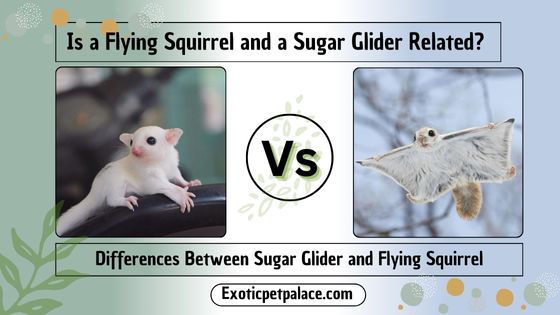Flying squirrels and sugar gliders, both nocturnal creatures known for their gliding abilities, often spark curiosity and confusion among nature enthusiasts.
While they share similar lifestyles and habitats, they belong to distinct taxonomic families and exhibit unique characteristics.
This article delves into the fascinating world of these gliding mammals, exploring their similarities, differences, and adaptations.
For more amazing content visit our You Tube Channel👇
Similarities Between Sugar Glider and Flying Squirrel:
Here are few similarities between Sugar glider and Flying Squirrel:
Gliding:
Both flying squirrels and sugar gliders are adept at gliding, a form of aerial locomotion that enables them to travel efficiently through the trees.
Their patagia, or gliding membranes, extend from their wrists to their ankles, creating a wing-like structure that allows them to soar through the air.
Nocturnality:
Both animals are primarily active at night, adapting their senses and behaviors to the darkness.
They rely heavily on their sense of hearing and touch to navigate their surroundings and locate food.
Their large, round eyes are well-suited for low-light conditions, allowing them to see in the dark.
Differences Between Sugar Glider and Flying Squirrel:
Here are few differences between Sugar glider and Flying Squirrel:
Taxonomy and Physical Characteristics
Let’s learn details:
Taxonomy:
Flying squirrels belong to the Sciuridae family, which also includes ground squirrels, chipmunks, and marmots.
They are placental mammals, meaning their young develop inside a uterus. Sugar gliders, on the other hand, are part of the Petauridae family, which includes other gliding marsupials such as possums.
They are marsupials, meaning their young are born in an undeveloped state and complete their development in a pouch on their mother’s abdomen.
Physical Appearance:
While both animals have similar body shapes, there are distinct differences in their physical features.
Flying squirrels typically have larger, rounder eyes, fluffy fur, and a bushy tail. Their fur color can vary widely, from gray to brown to black.
Sugar gliders, being marsupials, possess a pouch on their abdomen where they carry their young.
They also have a distinctive “bald patch” on their chests, which is used for thermoregulation. Their fur is usually gray or brown, often with darker markings.
Size:
Flying squirrels exhibit a wider range of sizes, with some species being quite large.
For example, the northern flying squirrel can grow up to 16 inches long, excluding its tail.
Sugar gliders, on the other hand, are typically smaller and more slender, reaching a maximum length of about 12 inches.
Habitat and Range:
Both have flying abilities. Here are few differences between Sugar Glider and Flying Squirrel’s Habitat and Range:
Habitat:
Both flying squirrels and sugar gliders are primarily found in forested habitats, where they can exploit the trees for food and shelter.
However, their specific geographic ranges vary. Flying squirrels are widely distributed across North America, Europe, Asia, and Africa, while sugar gliders are native to Australia, New Guinea, and parts of Indonesia.
Range:
Within their respective ranges, both animals may occupy different ecological niches.
Flying squirrels can be found in a variety of forest types, from deciduous to coniferous.
Sugar gliders, on the other hand, often prefer eucalyptus forests and other woodlands with a dense canopy.
Diet and Feeding Behavior:
Diet:
Both flying squirrels and sugar gliders are omnivores, consuming a diverse range of food items. Their diets typically include nuts, seeds, fruits, insects, and occasionally small vertebrates.
However, their specific dietary preferences may vary depending on the availability of resources in their habitat.
Feeding Behavior:
Both animals are primarily arboreal feeders, foraging for food among the branches of trees. They use their sharp claws and agile bodies to climb and maneuver through the canopy.
Flying squirrels are often solitary feeders, while sugar gliders are more social and may forage in groups.
Social Behavior and Reproduction:
Social Behavior:
Flying squirrels can be solitary or social, depending on the species. Some species form small family groups, while others are more territorial.
Sugar gliders are highly social animals, living in colonies of up to seven individuals.
They are known for their playful and affectionate behavior, often engaging in grooming and cuddling with each other.
Reproduction:
Both flying squirrels and sugar gliders have similar reproductive strategies.
They typically breed once or twice a year, with females giving birth to litters of young. The gestation period and litter size can vary between species.
Flying squirrels give birth to fully developed young, while sugar gliders have a short gestation period and give birth to tiny, underdeveloped joeys that complete their development in the mother’s pouch.
Conservation Status and Threats:
Conservation Status:
The conservation status of flying squirrels and sugar gliders varies depending on the specific species and their geographic distribution.
Some species are considered common and widespread, while others face various threats.
For example, the northern flying squirrel is listed as “Least Concern” by the International Union for Conservation of Nature (IUCN), while the southern flying squirrel is considered “Near Threatened.”
Threats:
Habitat loss due to deforestation, climate change, and predation are among the primary threats to both flying squirrels and sugar gliders.
In addition, illegal pet trade and human-wildlife conflicts can pose risks to their populations.
Legal Status of Flying Squirrel and Sugar Glider Adoption
Both flying squirrels and sugar gliders are important components of their respective ecosystems. Keeping them as pets can contribute to their decline in the wild.
Some argue that keeping wild animals as pets is unethical, as it can lead to stress, suffering, and compromised quality of life for the animals.
Both flying squirrels and sugar gliders have specific dietary needs, habitat requirements, and social behaviors.
Providing adequate care for these animals can be challenging and may require specialized knowledge and resources.
Here are details about the Legal Status of Flying Squirrel and Sugar Glider Adoption:
Flying Squirrels
Flying squirrels are generally not considered suitable as pets and are often protected by wildlife conservation laws.
In most countries, it is illegal to keep a flying squirrel as a pet without a special permit or license.
This is due to their specific dietary needs, habitat requirements, and potential for behavioral issues when kept in captivity.
Countries Where Flying Squirrels are Typically Illegal to Keep as Pets:
Here is list of Countries Where Flying Squirrels are Typically Illegal to Keep as Pets:
- United States: While there may be some exceptions in certain states, flying squirrels are generally protected by federal and state wildlife laws.
- Canada: Flying squirrels are considered protected species in Canada.
- United Kingdom: It is illegal to keep a flying squirrel as a pet in the United Kingdom.
- Most European countries: Similar to the United States and Canada, flying squirrels are typically protected species in most European countries.
- Australia: Flying squirrels are not native to Australia, and it is illegal to import or keep them as pets.
Sugar Gliders
Sugar gliders, on the other hand, are sometimes kept as exotic pets in certain countries.
However, their legal status can vary widely depending on local regulations.
In some regions, it may be illegal to keep sugar gliders without a permit or license, while in others, they may be considered legal pets.
Countries Where Sugar Gliders May Be Legal to Keep as Pets:
Here is list of Countries Where Sugar Gliders May Be Legal to Keep as Pets:
- United States: The legality of sugar gliders as pets can vary from state to state. Some states have specific regulations or restrictions, while others may allow them without a permit.
- Canada: In Canada, sugar gliders are generally considered legal pets, but there may be provincial regulations or restrictions.
- United Kingdom: While sugar gliders are not native to the United Kingdom, they may be legally kept as pets with appropriate permits and licenses.
- Australia: As sugar gliders are native to Australia, they are generally not subject to the same restrictions as imported species. However, there may be specific regulations regarding their care and breeding.
Also read: Is It Legal To Own a Sugar Glider?
Can Flying Squirrels and Sugar Gliders Live Together?
The short answer is generally no.
While both flying squirrels and sugar gliders are arboreal and nocturnal creatures, they have distinct differences in their biology, behavior, and habitat preferences that make cohabitation challenging.
Here are some key reasons why it’s not recommended to house flying squirrels and sugar gliders together:
Different Dietary Needs:
Flying squirrels and sugar gliders have different dietary requirements.
Flying squirrels are omnivores with a more varied diet, while sugar gliders primarily consume nectar, pollen, insects, and sap.
Providing a suitable diet for both species in the same enclosure can be difficult.
Habitat Preferences:
Flying squirrels and sugar gliders may have slightly different preferences for their habitat.
Flying squirrels may prefer denser forests with more vertical structures, while sugar gliders may favor trees with a more open canopy.
Social Dynamics:
Flying squirrels can be solitary or social, depending on the species, while sugar gliders are highly social animals that thrive in groups.
The different social dynamics between the two species could lead to conflicts or stress.
Size Differences:
Flying squirrels can vary in size, with some species being quite large. Sugar gliders, on the other hand, are typically smaller and more slender.
The difference in size could lead to competition for resources or even aggression.
Health Risks:
Housing different species together can increase the risk of disease transmission.
While flying squirrels and sugar gliders are not known to share specific diseases, the close proximity of different species could create opportunities for cross-infection.
While it’s tempting to think that two arboreal, nocturnal creatures could coexist peacefully, the reality is that flying squirrels and sugar gliders have significant differences that make cohabitation challenging.
FAQs About Flying Squirrels and Sugar Gliders:
While it’s possible to keep a flying squirrel as a pet in some jurisdictions, it’s generally not recommended.
Flying squirrels are wild animals with specific needs that can be difficult to meet in a captive environment.
They require specialized care, including a large enclosure, a balanced diet, and social interaction.
Flying squirrels glide through the air using specialized membranes called patagia that extend from their wrists to their ankles. These membranes create a wing-like structure that allows them to soar between trees.
Sugar gliders are not designed for long-distance flight. Their gliding ability is primarily used to efficiently travel between trees in their arboreal habitat.
While they can glide impressively long distances compared to their size, they are not capable of sustained flight like birds.
Sugar gliders can be kept as pets in some countries, but it’s important to check local regulations. They require specialized care, including a large enclosure, a balanced diet, and social interaction.
Sugar gliders glide through the air using their patagia, similar to flying squirrels. However, they have a smaller and more slender body shape that allows them to glide more gracefully.
The distance a sugar glider can glide depends on several factors, including the height of the starting point, wind conditions, body weight, and terrain.
In general, sugar gliders can glide distances of up to 50 meters (164 feet) or more under ideal conditions.
However, their primary goal is not to cover long distances but to efficiently navigate their arboreal environment.
No, a sugar glider is not a flying squirrel. While both animals are known for their gliding abilities, they belong to different taxonomic families.
Flying squirrels are rodents, while sugar gliders are marsupials. They also have distinct physical characteristics and exhibit different behaviors.
Conclusion
While flying squirrels and sugar gliders share many similarities, including their gliding abilities and nocturnal lifestyles, they belong to distinct taxonomic families and exhibit unique characteristics.
Their differences in physical appearance, habitat preferences, and social behavior reflect their adaptations to their specific environments.
Understanding the similarities and differences between these fascinating creatures provides valuable insights into their ecology and conservation needs.

